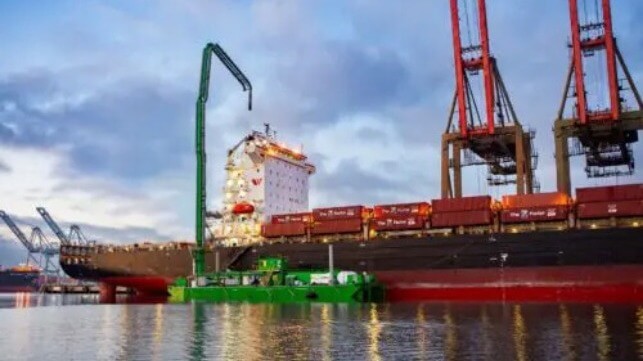Port of Hueneme Partners to Introduce Stack Caps to Reduce Emissions

California’s Port of Hueneme, which is used by commercial shippers for cargo including fresh produce and vehicles as well as the military, is launching a new partnership to reduce at-berth emissions through the use of a capture and control technology. The port is working with STAX Engineering presenting a cost-effective option for ships to meet California’s enhanced at-berth emission regulations while also helping the port manage after its shoreside power system was damaged by flooding in 2023.
The application is the next generation of STAX’s emissions capture and control system which consists of mobile floating barges that can place filters on ocean-going vessel stacks. The system filters the emissions while the vessel is on dock.
The Port of Hueneme’s shoreside power system used for cold ironing was damaged last December during major storms that hit the California coast. The Port of Hueneme flooded resulting in damage to the existing shore power systems.
“We must continue to move forward towards our goal of becoming a zero emissions Port. The storm damage has created an opportunity to continue showing how resilient our port can really be,” said Celina Zacarias, Board President for the Oxnard Harbor District which oversees operations at the Port of Hueneme.
The system works by positioning a barge alongside the vessel which positions a cap to envelope a vessel’s smokestack and capture the particulate matter and oxides of nitrogen (NOx) emissions at the source. STAX says its patented technology removes 99 percent of particulate matter and 95 percent of oxides of nitrogen (NOx) before being released as purified gas.
“One of the most important aspects of STAX technology is that it breaks fleet operator dependence on the local grid,” said STAX Engineering CEO, Mike Walker. “Shore power isn’t always available due to factors like major storms, limited outlet access, and vessel incompatibility. Our solution addresses these challenges, providing an easy, cost-effective, and environmentally friendly solution that solves the at-berth regulation requirements for ports like the Port of Hueneme.”
In addition to providing an option for the ocean-going vessels, the barge will operate powered by renewable diesel. It will meet the California Air Resources Board (CARB) requirements for reduced emissions from harbor craft.
The system requires no modifications to the vessel’s stack, It permits vessels to continue operations at berth, including running diesel generators, without disrupting operations. It also does not require shore power.
Versions of STAX’s system have already been deployed for individual shipping companies berthing both in the port of Los Angeles and Long Beach. To date, STAX reports it has treated 83 vessels at-berth for a total of 4,000 tours and controlled 31 tons of pollutants. In March 2024, Japan’s NYK group reported that it would be deploying STAX’s system for its car carriers while they were docked in California.
CARB established emission regulations for ocean-going vessels in 2007, and in 2014, mandated that ocean-going containerships, passenger ships, and other vessels calling at California ports were required to reduce at berth emissions of nitrogen oxides (NOx), reactive gases (ROG), carbon dioxide, particulate matter (PM), and diesel particulate matter (DPM). The rules are being expanded in 2025 to more classes of vessels including car carriers and are being phased in between 2025 and 2027 for tankers. Harbor crafts are also required to reduce their emissions.
